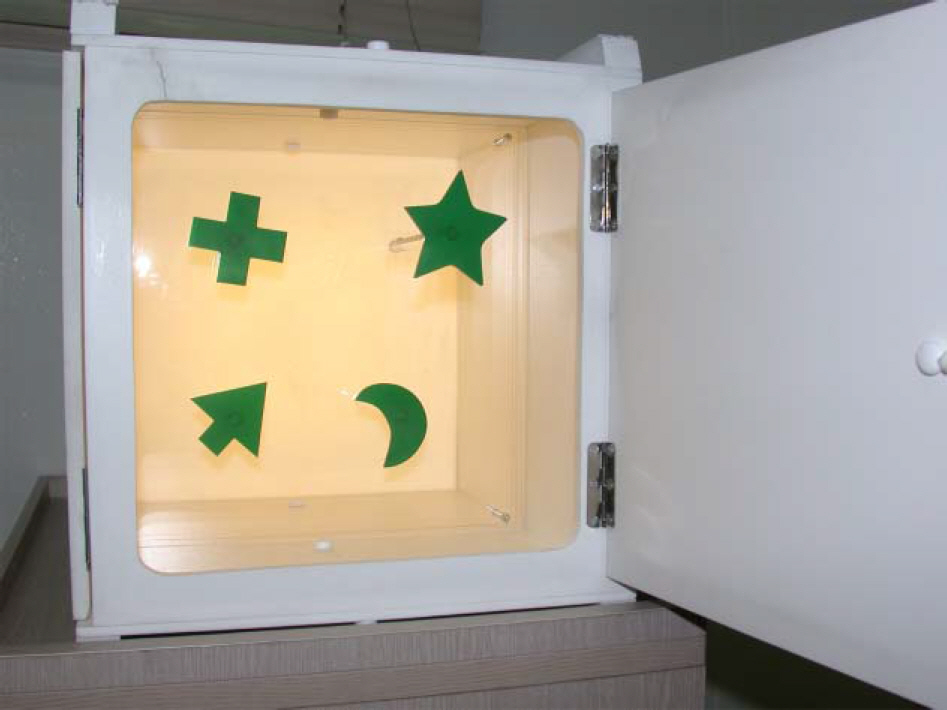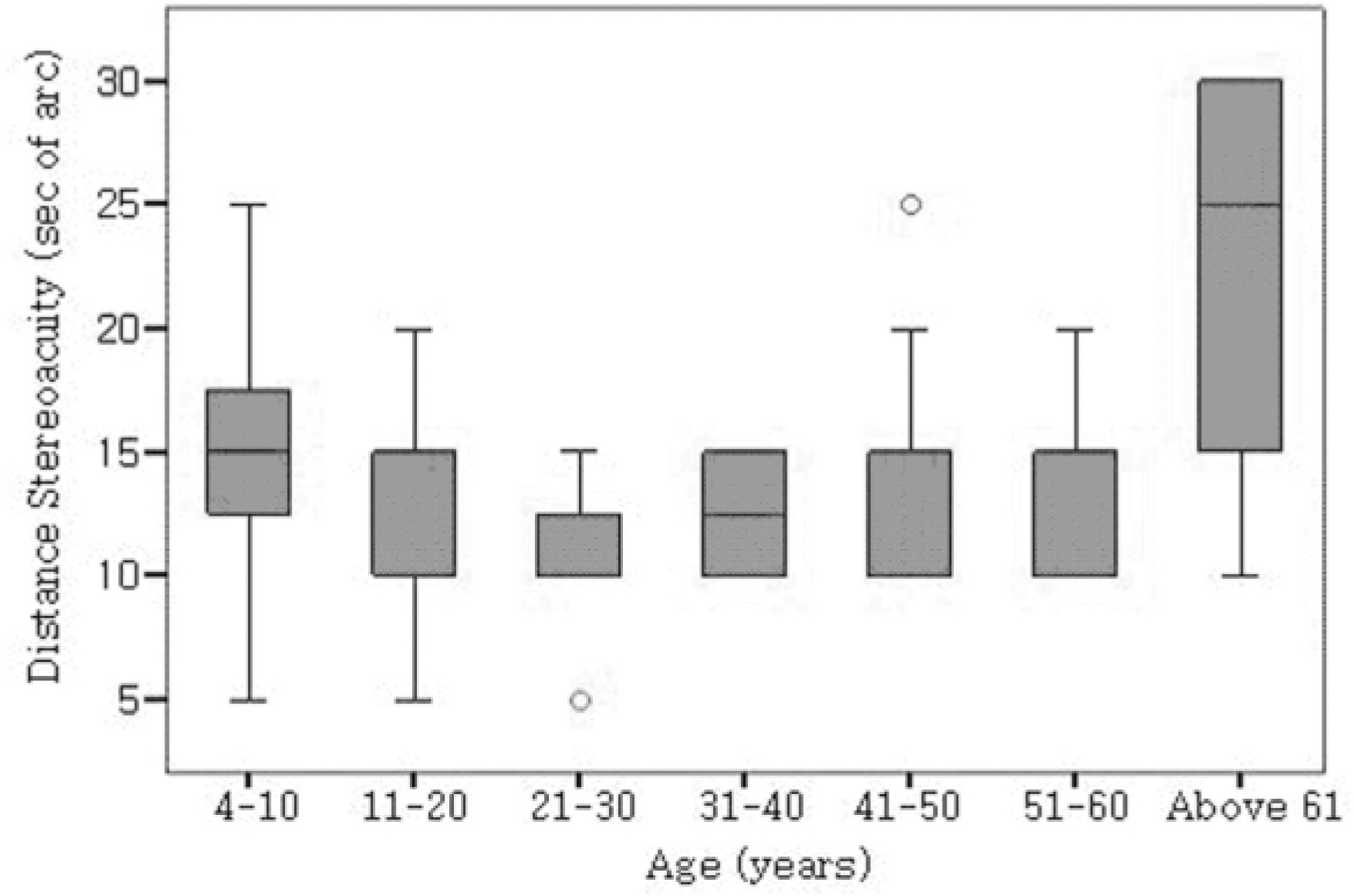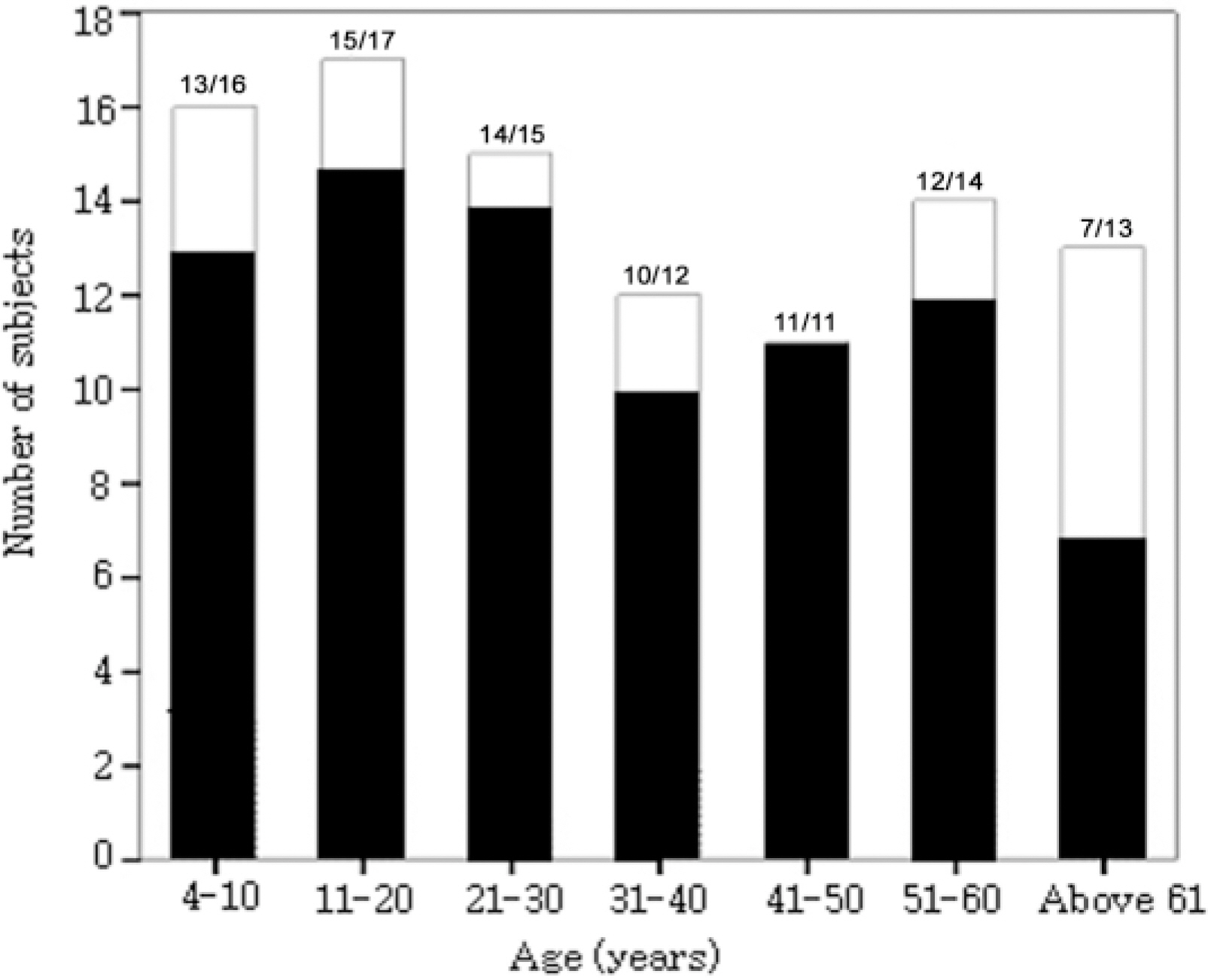J Korean Ophthalmol Soc.
2008 Jan;49(1):158-163. 10.3341/jkos.2008.49.1.158.
Normal Distance Stereoacuity by Age Assessed by the Frisby Davis Distance Stereotest
- Affiliations
-
- 1Department of Ophthalmology, College of Medicine, Catholic University of Daegu, Daegu, Korea. kimsy@cu.ac.kr
- KMID: 2211197
- DOI: http://doi.org/10.3341/jkos.2008.49.1.158
Abstract
-
PURPOSE: To determine the range of normal distance stereoacuity in populations with normal vision and the change of distance stereoacuity with age using the Frisby Davis Distance (FD2) stereotest and to evaluate the influence of monocular cues on the FD2 test.
METHODS
Ninety-eight subjects between 4 and 73 years old who had no ocular or neurologic diseases were examined. Distance stereoacuity was measured binocularly and monocularly with the FD2 test.
RESULTS
According to the results of the FD2 test, the mean distance stereoacuity of patients was 14.74+/-6.02 sec of arc. The monocular threshold with the dominant eye was 182.09+/-58.13 sec of arc. Subjects between 21 and 30 years old showed the best distance stereoacuity of 10.67+/-3.20 sec of arc. A significant decline in distance stereoacuity and monocular threshold were seen in subjects older than 61 (p<0.001).
CONCLUSIONS
The normal distance stereoacuity using the FD2 was 14.74+/-6.02 sec of arc, and significant reductions of stereoacuity and monocular threshold were seen in subjects older than 61. Therefore, we have to consider the effect of age on stereoacuity when performing the FD2 test. To take monocular cues into account, the FD2 test should be performed under both binocular and monocular conditions.
Keyword
MeSH Terms
Figure
Reference
-
References
1. Kim HY, Lee SY, Lee YC. The usefulness of Titmus test and distance stereoacuity using B-VAT® in intermittent exotropes. J Korean Ophthalmol Soc. 2004; 45:1330–5.2. O'Neal TD, Rosenbaum AL, Stathacopoulos RA. Distance stereoacuity improvement in intermittent exotropic patients following strabismus surgery. J Pediatr Ophthalmol Strabismus. 1995; 32:353–7.3. Suh WJ, Lee UK, Kim MM. Change of postoperative distance stereoacuity in intermittent exotropic patients. J Korean Ophthalmol Soc. 2000; 41:758–63.4. Roh YB, Kim CM, Oum BS, Lee JS. Distance stereoacuity in children with intermittent exotropia using B-VAT® II Video Acuity Tester. J Korean Ophthalmol Soc. 1998; 39:578–83.5. Zanoni D, Rosenbaum AL. A new method for evaluating distance stereoacuity. J Pediatr Ophthalmol Strabismus. 1991; 28:255–60.6. Stathacopoulos RA, Rosenbaum AL, Zanoni D, et al. Distance stereoacuity: Assessing control in intermittent exotropia. Ophthalmology. 1993; 100:495–500.7. Lee SY. Comparison of distance and near stereoacuity in normal and intermittent exotropic children. J Korean Ophthalmol Soc. 2001; 42:624–9.8. Adams WE, Hrisos S, Richardson S, et al. Frisby Davis distance stereoacuity values in visually normal children. Br J Ophthalmol. 2005; 89:1438–41.
Article9. Garnham L, Sloper JJ. Effect of age on adult stereoacuity as measured by different types of stereotest. Br J Ophthalmol. 2006; 90:91–5.
Article10. Fu VL, Birch EE, Holmes JM. Assessment of a New Distance Randot Stereoacuity Test. J AAPOS. 2006; 10:419–23.
Article11. Holmes JM, Birch EE, Leske DA, et al. New test of distance stereoacuity and their role in evaluating intermittent exotropia. Ophthalmology. 2007; 114:1215–20.12. Hong SW, Park SC. Stereoacuity of normal subjects assessed by Frisby Davis Distance Stereotest. J Korean Ophthalmol Soc. 2006; 47:154–9.13. Yap M, Brown B, Clarke J. Reduction in setereoacuity with age and reduced retinal illuminance. Ophthalmic Physiol Opt. 1994; 14:298–301.14. Brown B, Yap MK, Fan WC. Decrease in stereoacuity in the seventh decade of life. Ophthalmic Physiol Opt. 1993; 13:138–42.
Article15. Wright LA, Wormald RP. Stereopsis and ageing. Eye. 1992; 6:473–6.
Article16. Lee SY, Koo NK. Change of stereoacuity with aging in normal eyes. Korean J Ophthalmol. 2005; 19:136–9.
Article17. Yildirim C, Altinsoy HI, Eakut E. Distnace stereoacuity norms for the Mentor B-VAT II-SG videoacuity tester in young children and young adult. J AAPOS. 1998; 2:26–32.18. Holmes JM, Fawcett SL. Testing distance stereoacuity with the Frisby-Davis (FD2) test. Am J Ophthalmol. 2005; 139:193–5.
- Full Text Links
- Actions
-
Cited
- CITED
-
- Close
- Share
- Similar articles
-
- Stereoacuity of Normal Subjects Assessed by Frisby Davis Distance Stereotest
- Distance Stereoacuity by Frisby Davis Distance Stereotest after Surgery in Intermittent Exotropic Patients
- Correlation between Frisby-Davis Distance Stereoacuity Scores and Long-term Surgical Outcomes in Intermittent Exotropia
- Effect of Illunmination on Stereoacuity
- Comparison of Distance and Near Stereoacuity in Normal and Intermittent Exotropic Children




